For four hundred years, the Northern Bald Ibis disappeared from European skies. Today, thanks to the work of conservationists, nearly 300 reintroduced birds make their yearly pilgrimage between their breeding grounds in Austria and their wintering grounds in Spain. This was the first attempt to reintroduce a continentally extinct migratory species and the journey has been one of creativity, nerve and incredible determination. It begins 30 years ago with Johannes Fritz, a conservationist in Austria.
Tracing the history of a locally extinct species is no easy feat but with the help of historical data, scientists have been able to piece together the Ibis’ story. Hunted to extinction in Europe in the middle ages, the birds began to make their way back during the 1950s when individuals were captured from the wild populations in Morocco and placed in European zoos. The first steps towards a wild European population was rearing zoo-bred birds.
At a research station where Johannes was working as a PhD student in the 1990s, young Ibises were reared and kept entirely free flying. According to Johannes, the birds were healthy and flying well until late one summer when they are disappeared. Reports came in from across Europe that Johannes’ Ibises were turning up in unexpected and entirely unsuitable places. Most of the birds were lost. Unlike their sedentary Moroccan counterparts – and to the surprise of the scientists studying them – the European birds were revealing themselves to be migratory. The challenge facing these young Ibises was where to go, and with no apparent innate knowledge of suitable wintering sites which some birds are born with, their wild cameo into 21st century Europe was looking to be short-lived. The birds needed a guide to show them where to travel and were they not the first of their kind to make this journey for four centuries, their guide would be an older, more experience bird.
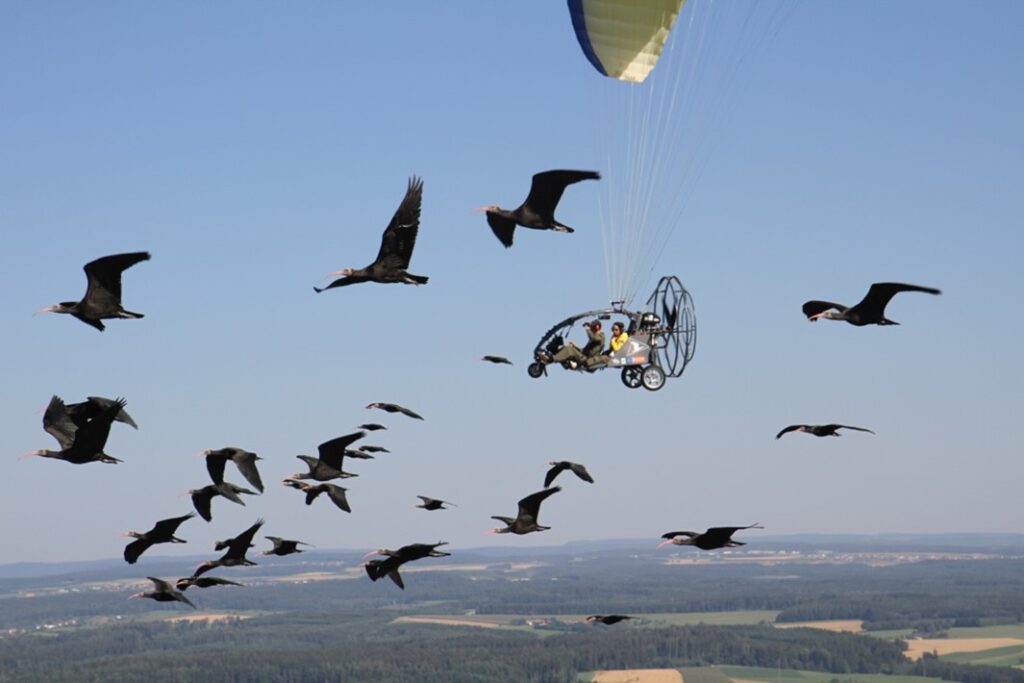
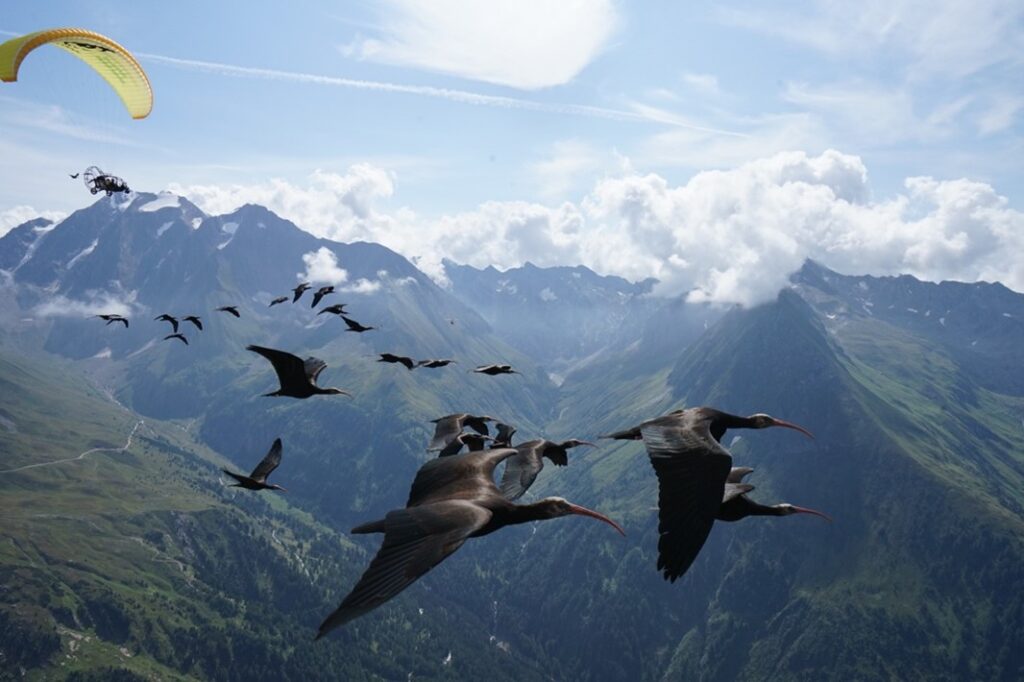
A Hollywood-inspired voyage
While the young Ibis were getting lost across Europe, the Hollywood movie, ‘Fly Away Home’, was enchanting viewers across the world. A heart-warming story about a girl who flies with Canada Geese, based on the true story of Bill Lishman. For Johannes, this film was the spark that ignited his own flying adventure and in 2003, he took to the air in a small microlight with his group of Ibis in tow, travelling with them across the Alps to Tuscany. One successful migration became many as the project receive EU LIFE funding. A single trip with the microlight is enough to give an Ibis an internal map that lasts a lifetime. The project was a huge success and played a significant role in the international conservation efforts that moved the status of the Northern Bald Ibis from ‘Critically endangered’ to ‘Endangered’ in 2018.
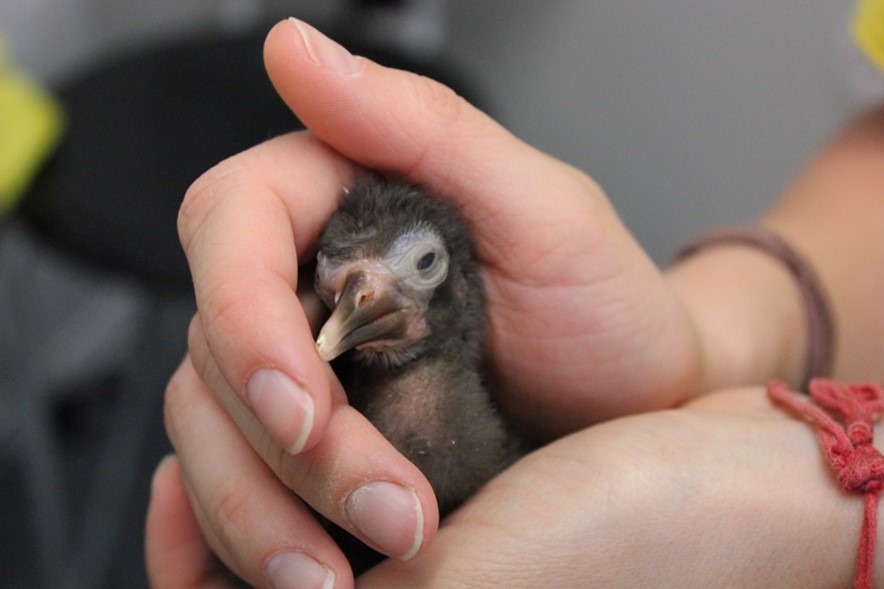
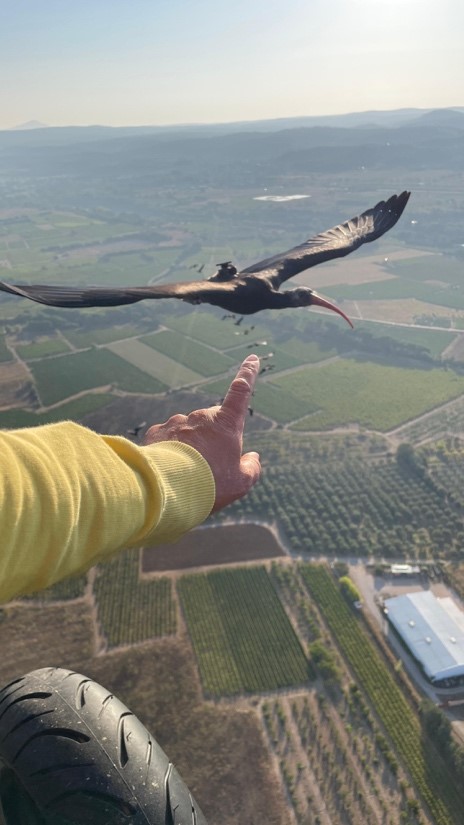
Parenthood
The trick to persuading the Ibis to follow the microlight is to persuade them to imprint on a human foster parent. In the wild, imprinting helps young birds to identify their parents amongst the many other birds that may be in a breeding colony. Each year, two people become Ibis foster parents and are charged with the task of hand-rearing the chicks, spending seven days a week with them from April to October. “It is a tough job” says Johannes, “but also exciting”. If the foster parents are to successfully lead the birds to their wintering sites, they must build strong connections with each, only then will the birds follow the microlight. While raising the chicks, the foster parents repeatedly call to them “komm komm, Waldi, komm komm” mean “come come, Bald Ibis, come come”. During the migration one foster parent sits in the back of the microlight with a megaphone and if the birds stray too far a “komm komm, Waldi, komm komm” brings them back to the group. The bond between them is so strong that at points during the journey, the individuals will fly close to the microlight and greet their foster parent with a characteristic call and raise of their bill. The foster parent, mimicking the bill with an extended finger, returns the greeting.
A new challenge
After two decades of successful trips, this wonderful migration faced an obstacle which threatened to undo everything. In just 12 years, the Ibis’ urge to migrate shifted by over a month, from late September to November. This astonishingly fast shift was a reaction to longer lasting and more intense warm periods during the autumn. The problem came to a peek when the birds tried to fly over the Alps. Later in the year, the thermal updrafts that carry the birds upwards over the mountains are much weaker, making it harder for the birds to gain the necessary height. At one point, 40% of the birds were unable to migrate – a serious problem as the harsh winters north of the Alps are far too cold for Ibis. “For several years, the team has been catching the birds at the start of winter and bringing them over the Alps to be released on the other side. But this is a complex emergency response”, says Johannes. To save his Ibis from a second extinction in Europe, Johannes has to find a new migration route. This route leading to Andalusia, Spain is three times longer, stretching for 2,700km and lasting a total of 52 days in 2024, avoids mountains and has now successfully been taught to a two generations of Ibis.
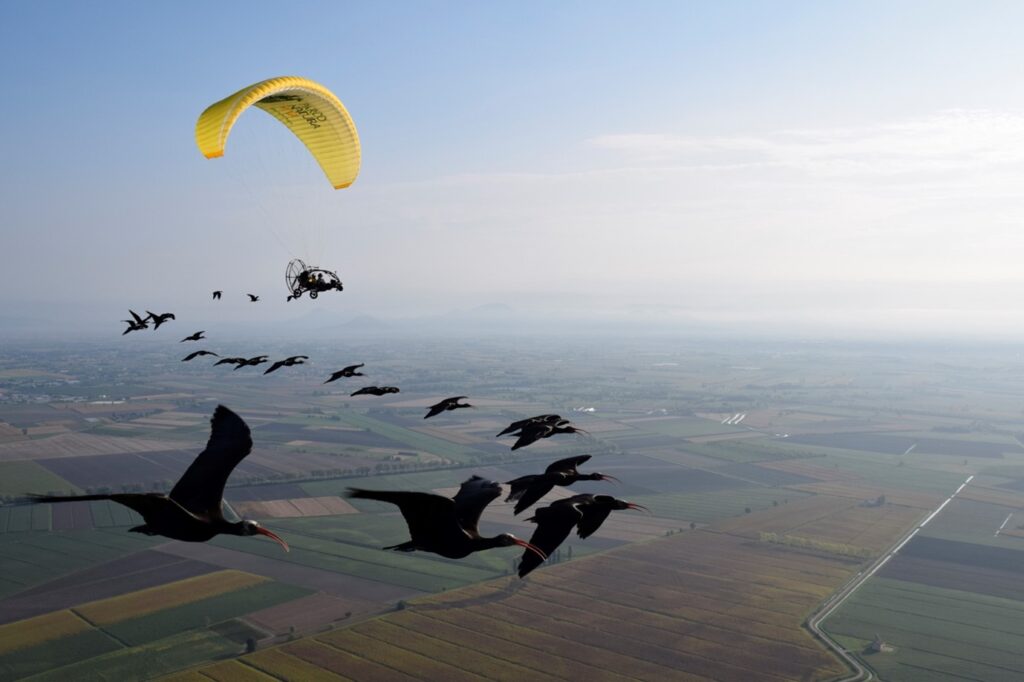
Final hurdle
Johannes estimates that to have a self-sustaining population of Northern Bald Ibis in Europe, we need about 350 wild individuals. At around 300 individuals at the time of writing, his team are on the brink of success, but there are still challenges waiting for the birds at the end of their migration. As a protected species, it is illegal to shoot Norther Bald Ibis, but once they arrive in Italy, they still face the threat of illegal hunting. Johannes and his team are using GPS tags to track the birds and to monitor cases of illegal hunting. The other challenge the team faces is electrocution, with 40% of mortalities caused by electrocution resulting from birds roosting on powerlines. Whilst smaller species can safely roost on powerlines, the size of an Ibis is enough to bridge the gap between two powerlines, resulting in a short circuit and a current passing through the bird, instantly killing the individual and any others roosting with it. A study across the African-Eurasian flyway found that electrocution is responsible for 40.5% of the human-induced mortalities of all large migratory birds, making it a huge global problem. There is however, a simple solution. By isolating the powerlines in the area of the poles, the birds are no longer able to bridge the gap and the risk of electrocution disappears. In Europe, Germany is leading the way towards removing this threat, with 90% of powerlines now safe for roosting. Outside of Germany however, Johannes and other conservationists are still lobbying to bring the new laws to make power poles safe.
The northern bald ibis: a beacon of hope
Despite the ongoing challenges, the reintroduction of the northern bald ibis has been a huge success, paving the way for the reintroduction of other lost migratory species. “The bald Ibis is one of thousands of species on the red list. All of these species need us to take action” Johannes says. His team continues to research, raise awareness and lobby for policy changes that will benefit not just the northern bald ibis, but many other species as alongside them.
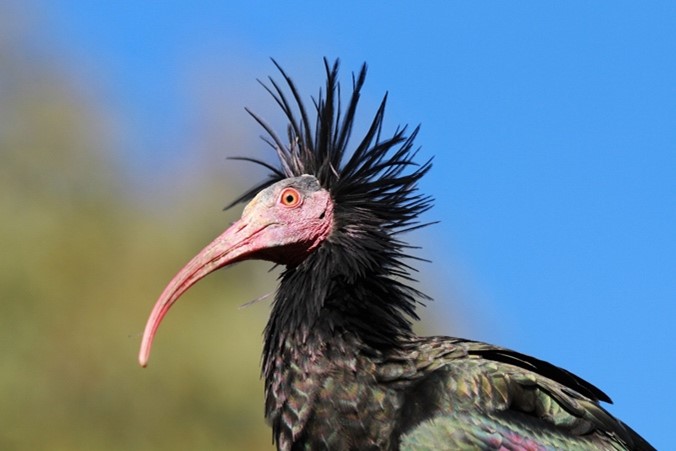
For more information and to keep up to date on the Waldrapp project, visit: waldrapp.eu